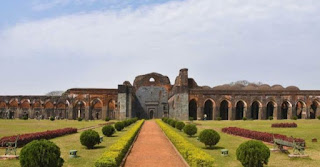Adina Masjid situated in Pandua, Malda, WB, is one of the largest mosques in the Indian subcontinent. It was built by converting a Hindu Mandir. This fact is also stated as following, “it was built taking pieces from a demolished Mandir” during the Bengal Sultanate by Sikandar Shah. The Masjid complex also contains Shah’s dargah.
According to scholars, the vast architecture of this mosque is associated with the hypostyle of the Umayyad Mosque, which was used during the introduction of Islam in new areas. Its construction absorbed materials from pre-Islamic Hindu and Buddhist structures. But what were these structures? Where were they located? Where are their ruins? Many questions remain unanswered.
Adina Mosque is included in the List of Monuments of National Importance in West Bengal by the Archaeological Survey of India (serial no. N-WB-81).
The mosque was designed to display the kingdom’s imperial ambitions after its two victories against the Delhi Sultanate in the 14th century. According to Encyclopedia Iranica, the mosque’s construction material included stones from Hindu temples. A few parts of the mosque’s exterior walls have carvings of elephants, dancing figures etc. Historians have considered whether the builders used stone from pre-Islamic structures or whether the mosque was built on the site of a pre-existing ruin.
The mixture of seemingly Buddhist, Hindu, and Islamic decorative characteristics of Adina Mosque has been questioned by many people. Wondering if this building is considered Islamic architecture or not, but with careful study it has become clear that this building was put together using Islamic traditions used in many other islamic architecture.
On 3 December 1932 AD, Jitu Santhal, the leader of an anti-landlord movement in North Bengal had engaged in his last combat at the ruins of the Adina mosque. A largeband of Santhals, who had recently converted to Hinduism, marched up to the historic city of Pandua, occupied the ruins of Adina, and conducted a debased form of Hindu worship in order to transform the mosque into a temple.
Jitu, who now called himself Gandhi, declared the end of British Raj and proclaimed his own government from within the mosque. Eventually, Jitu was killed in the vicinity of the mosque after a battle with armed police, who opened fire after the Santhals refused to come out.
The prayer hall at Adina.
Observing the prayer hall closely, one can assume that the raised platform was built later resulting in asymmetry in the construction of niches.
Source:
The architecture and architectural decoration of the Adina Mosque, Pandua, West Bengal, India: The problem of the conjoined Buddhist, Hindu and Islamic motifs in the mihrab niches – ProQuest”. ProQuest 304044113.
Eaton, Richard M. (1996). The Rise of Islam and the Bengal Frontier, 1204-1760. University of California Press. ISBN 978-0-520-20507-9.
“List of Ancient Monuments and Archaeological Sites and Remains of National Importance”. West Bengal. Archaeological Survey of India. Archived from the original on 27 June 2014. Retrieved 17 April 2020.
Banerji, Naseem Ahmed (1 January 2002). The Architecture of the Adina Mosque in Pandua, India: Medieval Tradition and Innovation. Edwin Mellen Press. ISBN 9780773472099 – via Google Books.
Hasan, Perween (15 August 2007). Sultans and Mosques: The Early Muslim Architecture of Bangladesh. I.B.Tauris. ISBN 9781845113810 – via Google Books.
electricpulp.com. “BENGAL – Encyclopaedia Iranica”.
Eaton, Richard Maxwell (1996). The Rise of Islam in the Bengal Frontier, 1204-1760. University of California Press. pp. 40–50. ISBN 0520205073.
“Adina Mosque – Banglapedia”.
María Dolores Elizalde; Wang Jianlang (6 November 2017). China’s Development from a Global Perspective. Cambridge Scholars Publishing. pp. 61, 68 and 69. ISBN 978-1-5275-0417-2.

